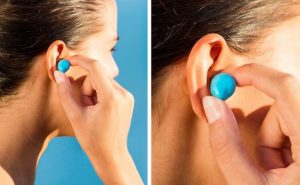3. How not to get the swimmer’s ear

Our ears are well protected from water by nature due to the shape of our earpiece. It does not allow water to enter and stagnate, while sulphur in ear wax retains acidic pH and kills bacteria and fungi. But the ear wax of people who swim a lot tends to be washed and that’s where the ears become vulnerable. Along with the weakening and overuse of the body, it can lead to otitis.
Doctors recommend wiping the ears with the corner of the tissue, drying them with a hair dryer (not with warm air but warm), and using alcohol-based ear drops. The perfect option would be to use special swimming hats and earplugs that are available in different shapes – mushrooms, balls and arrows. There are also child plugs and silicone-free plugs that are made of a hypoallergenic material with wax and almond oil.
4. Avoid harmful effects of salt and chlorine

To keep your skin healthy while swimming in the ocean, don’t forget to shower after. It will help cleanse the skin of toxins that are drawn by salt. After your shower, dry your skin thoroughly and apply a moisturizing lotion.
Chlorine pools often cause inflammation of the eyes, aging of the skin and deterioration of hair quality. How do you protect yourself? The best option is to use swimming pools where disinfection is done using ozone or ultraviolet. They add less chlorine to the water in these pools. A tight hat and glasses with a silicone frame can protect you in an ordinary pool.
Always remove makeup before swimming because the reaction of chlorine and cosmetics can cause an allergic reaction. In addition, apply coconut oil or nourishing cream all over your body. After swimming, take a shower with a shower and shower gel, wipe your body with a towel and apply moisturizers to linolenic acids, lecithin, vitamins A and E and oils. If swimming in an indoor pool, do not go out immediately after, especially in cold weather — wait 20 to 30 minutes for excess moisture to evaporate from the skin.


